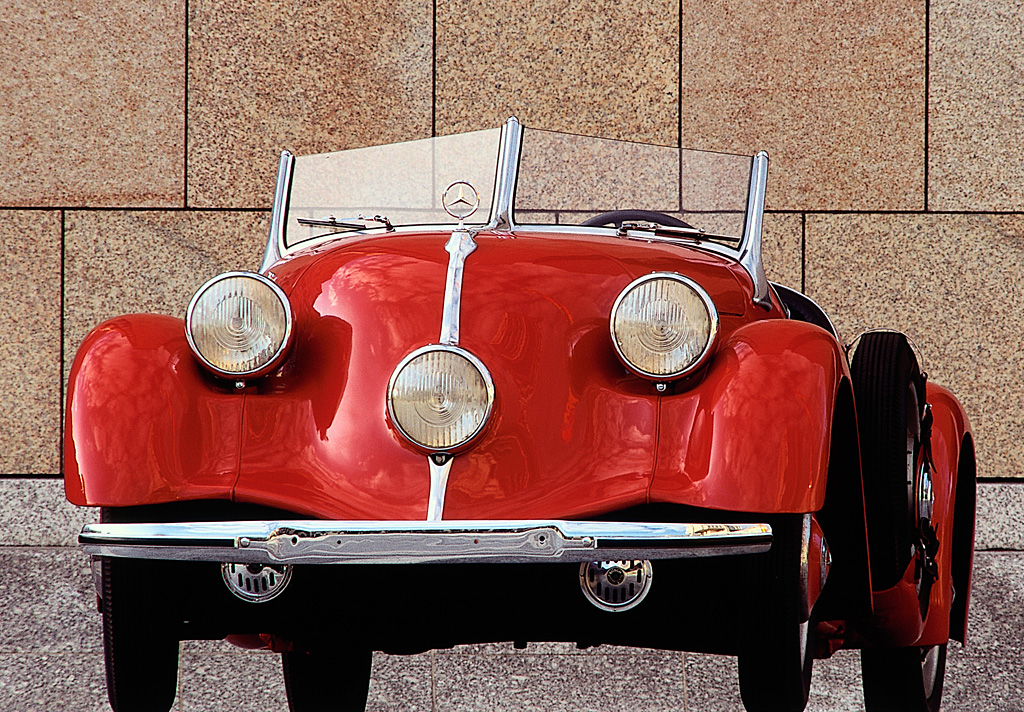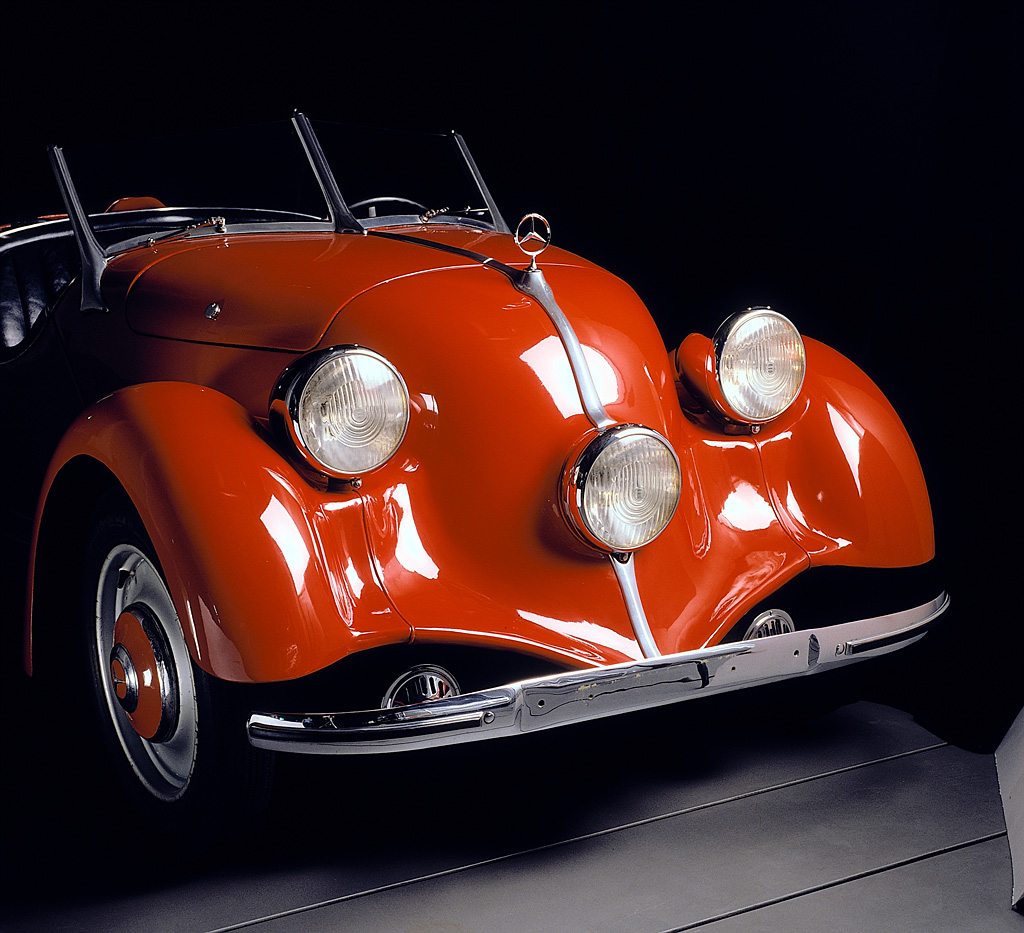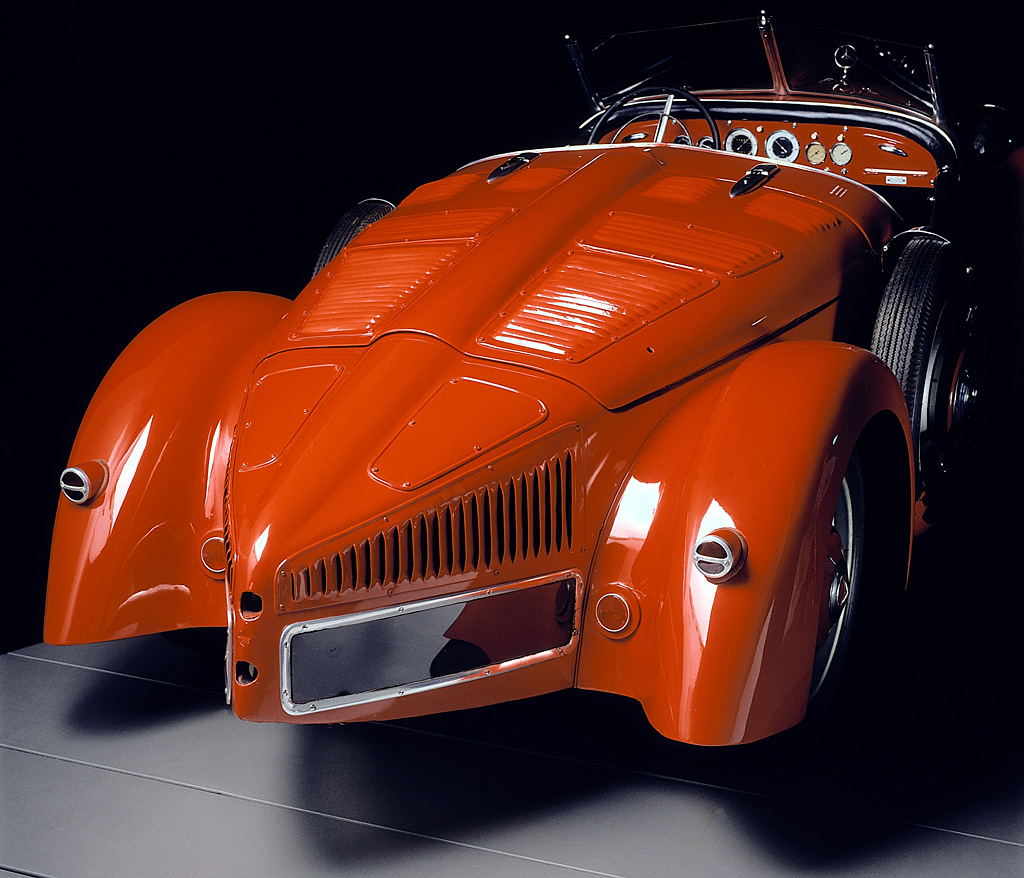1934→1936 Mercedes-Benz 150 Sportroadster
Following the success of the 2000-kilometre event in 1934, in August Kissel stressed “[…] that it was absolutely essential to bring out a small, streamlined sports car by the spring of 1935.” Thus in November 1934 the Daimler-Benz Board of Management decided to build two Sport Roadsters based on the Mercedes-Benz 150 for the 1935 IAMA in Berlin. One of these was to be presented at the exhibition stand, the other to be available for test drives. Delivery of the production units was scheduled for May.
Like Wilhelm Haspel as Head of the Sindelfingen plant, the Head of Testing Fritz Nallinger stated his position with respect to the new Sport Roadster in January 1935, making mention in particular of the compressed-air radiator, which was later also used in the 170 H model, the two spare wheels mounted on either side behind the doors and the centrally mounted high-beam headlamp at the front end.
The body design of the Sport Roadster was fundamentally different form that of the Sport Saloon. As an all-new design, it bore several typical features of open-top sports cars of the day, including, for example, the swept split front windscreen and the two free-standing spare wheels mounted in front of the rear wings. Also highly distinctive was the pointed boat-like rear end with its two licence plate holders. A free-standing Mercedes star was mounted at the front end.
One sales brochure hailed the vehicle as a “thoroughbred sports car”, highlighting the qualities of the sports engine and its outstanding power-to-weight ratio. “Each hp has a load of just 19 kg! This explains how the 150 has acceleration in every gear – and virtually on a par with that of a supercharged car.”
In terms of technical design, including the engine, it was identical with the Sport Saloon. The compressed-air cooling permitted the use of a smaller radiator, since the cool air was forced through the radiator by a blower driven by the engine. The small rectangular radiator was mounted behind the engine above the rear axle.
Behind the seats was stowage space for both the lightweight, button-on soft top and small items of luggage. And the front bonnet could accommodate a large suitcase and the fuel tank. The 150 model was offered at the 1935 IAMA with a price tag of RM 6,600.
The Mercedes-Benz 150 Sport Roadster remained a part of the official sales range until 1936, but was only built in extremely small numbers. Records vary as to the exact number of units produced. One production statistic puts the figure at 20 examples. The statistics for bodies produced at Sindelfingen records just five examples – one in 1934, four in 1935. On the other hand, the order books show just two deliveries. But one thing is certain: the 150 model was not only one of the rarest cars from the Mercedes-Benz brand, it was also one of the most technologically innovative vehicles of its day.
One 1936 Roadster is in the possession of Daimler AG. It was purchased second-hand in the early 1950s with a mileage of 44,500 kilometres thanks to the intervention of former Board of Management member, Jakob Werlin. It would appear to be the only surviving vehicle of this highly innovative model series.
Irvine Restoration
A business built on heritage, the Mercedes-Benz Classic Center in Irvine, California celebrates its fourth year in business by displaying a rare collection of rear-engine vehicles and successfully restoring its first museum car: a 1934 150 Sport Roadster, a rare mid-rear engine two seater that’s regarded as the only 150 known to exist. Two other rear-engine vehicles, the 130 and the 170 H, are also on display at the Mercedes-Benz Classic Center.
Drawing on the expertise of their highly specialized technicians and facility’s capabilities, the MB Classic Center provided a full mechanical restoration. With the preservation of the original parts and vehicle a priority, they re-built transmission, brakes, steering and suspension systems, engineered a new wiring harness to for safety and reliability and fabricated missing components in order to make the 150 Sport Roadster street capable after not running for approximately 60 years. One of the most technologically innovative vehicles of its day, the three headlight 150 roadster features a swept split front windscreen, two free-standing spare wheels mounted in front of the rear wings, and a highly distinctive pointed boat tail featuring two translucent illuminated licence plates. Purchased second-hand in the late 1940s with a mileage of 44,500 kilometres, the150 Sport Roadster has not been roadworthy since that time.
Visually different than the 150 Sport Roadster, the 130 and 170H rear-engine vehicles appear strangely familiar to most people who see them. Featuring a rounded body, expressive wheel arches and bug-eyes lights, the 130 and subsequent 170 H offered passengers an extremely efficient vehicle package. For vehicles with a relatively short wheelbase, the engine mounted in the rear afforded passengers more leg room and improved comfort by creating optimum springing between the axles. The 1934 130 was the first fully-developed mass-produced rear-engine car both in brand history and indeed in the entire history of the automobile. While Mercedes-Benz has the honor of bringing the rear-engine concept to a new level and making it more widely known, the run was short and the 1936 170 H was the last rear-engine mounted model that wore the star logo. In 1946, 10 years after Mercedes-Benz finished production, the “VW Beetle” went on sale and the profile became recognizable.
In Detail
| submitted by | Richard Owen |
| type | Series Production Car |
| production years | 1934 – 1936 |
| engine | Inline-4 |
| valvetrain | SOHC 2 Valves / Cyl |
| displacement | 1498 cc / 91.4 in³ |
| bore | 71 mm / 2.8 in |
| stroke | 92 mm / 3.62 in |
| power | 41.0 kw / 55 bhp @ 4500 rpm |
| specific output | 36.72 bhp per litre |
| driven wheels | Rear Engine |
| top speed | ~140 kph / 87.0 mph |












